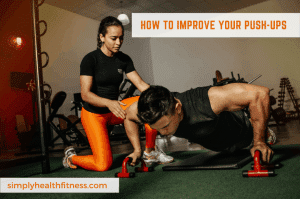How to improve your push-ups? quality and quantity.
By the end of this article, you’ll have the tools to perform more, better push-ups, and get more out of them.
Remember, the way you move and the way you train are key. Pay close attention to the demonstration videos for technique, as well as pick out the variations that suit you best!
Building Stronger Muscles and Fixing Weak Links
Knowledge produces results: improving is easy if you know how to get better at push-ups.
Fixing weak links builds well-rounded strength. It also increases the number of reps you can perform. This is what getting better looks like, but improving how many reps you can perform also helps your long-term progress: you can build more muscle and strength.
This mix of direct and indirect benefits pays off in the long-term.
Developing key muscle groups used in the push-up can be a simple way to blast through plateaus. The added variety alone could drive new progress, but smart exercise selection squeezes the most progress out of your training time.
We’re going to break these down into the 5 main muscle groups that play into a good push-up: the chest, triceps, shoulders, upper back, and core. If any of these is weak, your push-ups will suffer.
Join our 30-day push-up challenge.
Chest
The chest is a major reason to do a push-up in the first place. Too weak of a chest can limit progress, and the best way to improve your push-ups is building well-rounded upper body strength.
If you have a weak chest, you’re usually going to struggle at the bottom of the push-up. Isolating it can help you improve the whole movement, but specifically the bottom half.
Wide grip push-ups
Widening the “grip” of a push-up makes it more chest-dominant.
The chest and delts will progress, shifting focus away from the triceps. This is how to improve your push up fastest when you’re struggling with the bottom half of the movement.
Focus on shoulder control and keeping the chest “open” through each rep.
Offset push-up
Offset push-ups are all about getting into long ranges for the chest muscles. You’re probably going to feel the stretch in your chest as you perform them.
This additional range and single-arm focus is a great way of building shoulder stability for push-ups. It also exaggerates the range of the chest, mixing pressing and stretching movements for a more effective chest workout.
This is a hard exercise, so start with a strong incline to reduce the bodyweight you’re putting through your upper body.
Reverse grip / Maltese push-up
If you can get into performing Maltese push-ups, you’re going to see significant upper back and chest improvements.
This is like a wide-grip push-up but with a reversed grip and your weight shifted forwards, reducing support on the feet. This improves the recruitment of the chest and upper back (lower traps and lats), which is great for improving your control during a push-up. I would recommend using a pair of parallettes for the exercise.
Again, this is a challenging exercise, so begin at an incline where possible to get used to the movement.
Triceps
The triceps make up most of your arm mass, and they’re the main factor in how strong your lock-out is.
Building stronger triceps will improve the top half of your push-up. If you’re really struggling to get to lock-out, or you feel like you’re struggling more at the top, building better triceps is key.
Diamond push-ups
Diamond push ups are hard because you’re weaker in this position than a normal push-up. It takes out big muscles like the chest, leaving you to rely on tricep strength. That’s also why they’re great.
Obviously, this means the tricep gets all the gains. This can be great if you’ve got a weak lockout since you’re going to rapidly improve it with tricep strength and building elbow extension skill. More focus on a position tends to make it better.
Practice this on a raised surface (i.e. incline diamond push-up) to begin with, since it’s a challenging move.
Bodyweight skullcrusher / tricep extension
These are a great exercise you can perform on a squat rack, or a simple raised surface like a kitchen counter.
The full-range version on a bar moves you through the full range of the tricep. This is great for building complete strength and elbow/shoulder health, since the tricep crosses the shoulder.
The shorter version on a kitchen counter is more like a tricep extension, but can be used at high reps to build great triceps and a stronger lockout.
Shoulders
The shoulders shouldn’t be the prime mover in a push-up. We want to keep them stable throughout, supporting the chest and triceps as they do the work.
That stability work still requires strong, stable shoulders. This means getting strong with them through their full range and shoring up your stabilizer muscles (like the serratus anterior, for example).
Push-up plus
This is a simple exercise that works through the normal range of a push-up, then has you add more range using the serratus anterior.
It’s great for training oft-ignored muscles. It also makes regular push-ups more challenging, so you can include them as part of your overall training volume since, rep for rep, they’re going to be more challenging.
Swapping your normal push-ups out for these could, alone, be a way of progressing – as long as you’re performing the same number of reps/sets.
Stability ball push-up
Adding a stability challenge to your push-ups can improve your control over the normal push-up.
By challenging the smaller, stabilizer muscles that may go neglected in normal push-ups, you can make them stronger and build your control over them. This is great for long-term development as well as keeping your shoulders healthy.
You will need a stability ball to perform the exercise.
Ring push-up
These combine some of the instability training of a ball push-up with increased range in the shoulders and chest. This means better stability and improved muscle/strength gains.
This makes ring push-ups one of the best ways to develop your overall pressing strength. They can be performed at almost any height/incline, and you can lower them slowly over time as you get stronger.
You will need gymnastic rings to perform this exercise, but those are a great piece of training kit to have around.
Upper Back
The upper back muscles control the shoulders and posture during a push-up. Developing these is how to improve push-ups if you’re wobbly or uncertain through the movement.
Bigger, stronger backs make you better in pressing. They’re the foundation for good pressing.
‘Swimmer holds’ / scaption
This is a simple practice in moving your upper back properly. It builds the control and awareness you need to build better push-ups and advanced variations.
Practice scaption daily for the best results. It’s going to help keep your shoulders and posture healthy, as well as improving your shoulder and elbow positioning in the push-up.
Hand-release push-up
This basically takes the scaption mentioned above and ensures you’re using the same positions during your push-up. It’s a form of push-up that focuses on how you’re moving.
The point is to really focus on your upper back and core when you take your hands off the floor, then keep them there as you perform the push-up.
It’s not a revolutionary exercise, but it builds better push-up technique, which builds better results.
Pike press
This is a great exercise for so many reasons. It’s harder than a push-up, but will light up your upper back quickly.
Even if you struggle to get high-rep sets out with the pike press, it’s going to build muscle mass, as well as improving shoulder and upper back control. These are key for a good push-up.
This is a great exercise in it’s own right, but will rapidly improve the quality of your push-ups. Even if you’re performing low-rep sets, this can be a great choice before easier push-up variations.
Core
A flaccid core leaves you overcompensating through your reps.
There are a few reasons this is a problem. Firstly, it means you’re doing it wrong – which is always worth avoiding.
Second, a weak core places unnecessary stress on the spine and offsets the proper leverage of the movement. This makes it unpredictable and inconsistent, as well as adding stress to your lower back.
Finally, it completely robs the exercise of the point. It can easily compensate to make a push-up easier (compensating by raising the hips), which robs you of the actual chest and tricep stimulus you need to get bigger and stronger.
A strong core means doing it right and
Plank Position
This is a classic, simple core exercise. Get into position and hold the position.
It’s the same core position you’ll need for a push-up, so it’s very specific to you goals. Practice on your elbows to start with, before moving to a plank in the locked-arm position.
This makes it a great exercise for your lockout and your core strength training.
8pt plank
This is what you need when the normal plank position isn’t cutting it.
This exercise practices keeping your core position stable under a more challenging position. It also lets you get a great core workout with sets of 15-30 seconds at a time, instead of minutes like a normal plank position.
Hollow hold
Hollow holds exaggerate the position of the core, which can build a ton of surplus core strength. It means a rock solid trunk when you’re training push-ups.
You can also perform push-ups in a hollow body position, which is perfect for strength training for advanced bodyweight skills.
FAQ
How to Progress Push-Ups?
I’m often asked how to improve push up reps. The key to getting better at push-ups is overload – making sure you’re doing more total work each week.
This drives the muscle and strength gains that allow you to use harder variations and increase your push-up reps.
It’s how to increase your strength for push-ups, but also for everything else.
You can see significant improvements to your performance in as little as 1-2 weeks, and in your physique within the first 4-6 weeks.
How often should you train?
There’s no hard-and-fast rule. It all depends on what your sessions look like. If you’re doing push-ups for 45 minutes, you’re going to need more rest than after a 20-minute workout.
Beginners should train every other day, intermediates should aim for 2 days of training to 1 day of rest, and more-experienced trainees can start experimenting with 3:1 or everyday sessions.
Bodyweight training responds well to this “higher frequency” training since you’re using relatively small loads. However, be honest with yourself – too much too soon will stall your progress and increase injury risk.
How can you push progress?
Overloading and progressing are tied together. You have to constantly challenge yourself to force muscular adaptation.
There are a few way to do this:
- Progress reps – you can add a rep to sets, or work through fewer sets for a rep goal. These both have you doing more reps in a shorter space of time, stimulating muscle growth.
- Progress sets – add more sets over time. If you’re doing three sets of 10, moving up to 5 sets will add significant extra volume. This helps you build in the long-term.
- Mix it up – variety in your exercises, using the variations mentioned above for example – produces muscle and strength gains. Progress the fundamentals, and vary the rest!
- Train more often – training more often means more weekly volume, as explained above.
- Use harder variations – progressing through push-ups means adding more load to your muscles per rep – which adds up fast. More challenging variations produce better results.
Quick-Fire Training Tips for Better Push-Ups
There’s more to improving your push-ups than adding in variations. The way you approach your workouts also factors into your progress.
Workout design matters. Using systems like top sets with a challenging variation, then “back-off” sets with simpler exercises can help accumulate a ton of volume. This drives muscle and strength gains.
You can also try rep-goal sets, where you aim for a number of total reps in as few sets as possible. AMRAP sets stand for “as many reps as possible” and are another good tool for building volume.
Usually, you want a more challenging start to a workout, then to get into gradually ‘smaller’ and easier exercises towards the end as you get more tired.
Weekly testing on a movement or variation can push you to keep progressing and defeat complacency. It’s important to keep trying to improve along some measure – either quality or quantity.
Variety drives muscle growth, as long as you’re not just doing whatever you fancy all the time. Stick to a core exercise (like the normal push-up) and vary the other exercises/variations around it.
Angles make the difference in bodyweight training. Use inclines to make exercises easier, and declines to make them harder. This can ensure any exercise is an effective training tool, whatever your personal strength/experience levels.
Slow and/or paused reps add a new dimension. Pauses build strength in a specific area – so use them where you’re weakest. Slowing down the tempo helps build better technical awareness, stability, and tendon strength.
You can use these variations to make a top set harder, then use a simpler movement without them to add in more volume.
Technique is always key, and that’s why I’ve saved it for last. Because you need to remember: every exercise is only as good as you make it. The way you perform it and your standards for your movement determine your results.
“How to increase your push-up strength” is second to “how to improve your push-up form”. Pay attention to the demonstration videos – technique is where the benefits come from.
Final Thoughts
Push-ups are versatile, but they can also be challenging as a beginner. As you progress, you can start challenging yourself with even more complicated and challenging exercises.
This is the beauty of the push-up: it’s as easy or difficult as you make it – and it grows with you.
Doing them right, and practicing variations that work on your weaknesses, is how to get better at push-ups. It’s that simple, and that difficult.
We’ve set out a brief system for getting better at push-ups and some of the best variations to use in that system. Take a step back, work on your weaknesses, and you’ll come back stronger and better than before.





